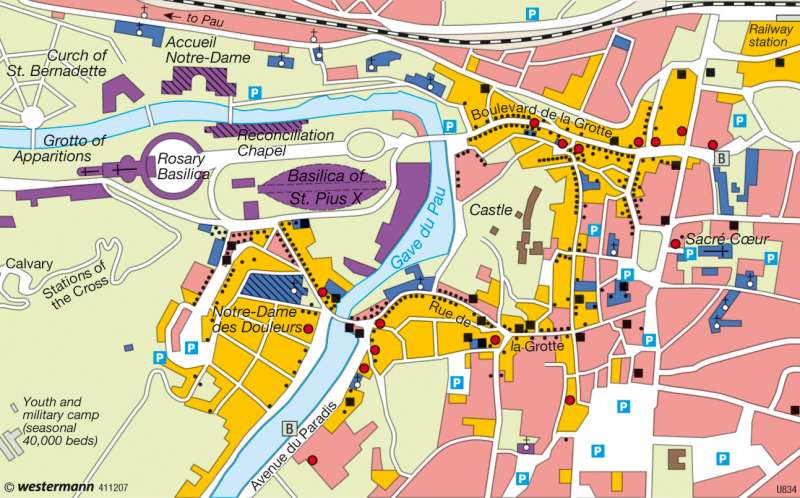Lourdes — Pilgrimage town
History and religion in maps - Searching for traces
978-3-14-100790-9 | Page 23 | Ill. 2

Information
Pilgrimages represent a special category of tourism. They are primarily religiously motivated (Christianity, relief of suffering, thanksgiving). In places of pilgrimage a special tourism infrastructure is typical: holy places, hostels for pilgrims, youth camps, asylums for the sick, or shops selling devotional articles.The map shows the functional structure of the pilgrimage town. The religious centre is located in the north-west. Adjoining it in the south and east are lodging houses and restaurants. The Rue de la Grotte and the Boulevard de la Grotte, together with their side streets, are marked by devotional article shops, travel agencies for the booking of day trips, and eating places. In 1858, the year of the appearance, the market town had about 3,000 inhabitants. Its development into a pilgrimage town resulted in a sharp increase in population to today's 18,000, a change in the employment structure (services), spatial growth and an expansion in the infrastructure. In the high season, Lourdes can accommodate five times as many visitors as the number of inhabitants.
The development of Lourdes began in 1858 with the appearance of the Virgin Mary to a peasant girl. This was followed by its rapid development into the second-largest international Christian pilgrimage centre (after Rome). The diagram in the map shows the peak numbers of pilgrims at the times of important festivals (reaching their high point in 1958 with nearly 5 million visitors).
About two-thirds of the pilgrims come from Italy and France. About one-third arrive in Lourdes by rail (in special trains), about half by car, and the remainder in buses and by air (charter flights). The social structure shows a majority of female pilgrims (more than two-thirds), older people (40% are aged above 60), workers and people from rural areas. The pilgrimage season lasts from March until October. Alongside the religious activities, one day is usually set aside for bus tours to the nearby Pyrenees or the Atlantic coast. In the winter months the labour force finds employment in the tourist centres in the Pyrenees.
R. Pertsch, G. Rinschede; Ü: J. Attfield




